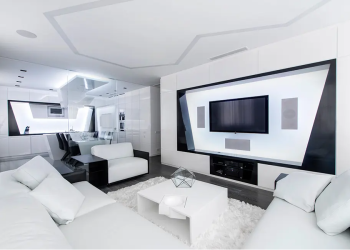Introduction
In a world filled with constant noise and distractions, minimalist home decor offers a serene sanctuary of simplicity and style. Embracing the principles of minimalism allows homeowners to create spaces that are both visually appealing and highly functional. This article explores the fundamentals of minimalist home decor and provides practical ideas for achieving a simple yet stylish living environment.
Principles of Minimalism
At its core, minimalist home decor revolves around the principles of simplicity and functionality. By stripping away excess and focusing on essential elements, minimalist spaces exude a sense of calm and clarity. Embracing minimalism is not merely about owning fewer possessions, but rather about curating a living environment that enhances well-being and fosters a sense of tranquility.
Color Palette
A key aspect of minimalist home decor is the use of a neutral color palette. Shades of white, beige, and gray dominate minimalist interiors, creating a canvas of tranquility that allows other elements to shine. Accents of color can be introduced sparingly to add visual interest and depth to the space, but the overall aesthetic remains understated and cohesive.
Furniture Selection
When selecting furniture for a minimalist space, opt for pieces with clean lines and sleek designs. Avoid ornate detailing and opt instead for furnishings that prioritize function over form. Multi-functional furniture, such as storage ottomans and modular shelving units, maximizes space efficiency and minimizes clutter.
Decluttering and Organization
Central to minimalist home decor is the practice of decluttering and organization. Streamline belongings to only the essentials, keeping surfaces clear and uncluttered. Effective storage solutions, such as hidden cabinets and built-in shelving, help maintain a tidy and organized living environment.
Natural Elements
Incorporating natural elements into minimalist decor adds warmth and texture to the space. Bring the outdoors in by incorporating plants and greenery, which not only enhance air quality but also evoke a sense of serenity and connection to nature. Additionally, opt for natural materials such as wood and stone to add depth and visual interest to the space.
Lighting
Maximizing natural light is essential in minimalist home decor, as it creates an airy and spacious atmosphere. Opt for sheer curtains or blinds that allow sunlight to filter into the room. Supplement natural light with minimalist lighting fixtures, such as pendant lights and recessed lighting, to create a warm and inviting ambiance.
Texture and Contrast
While minimalist decor is characterized by simplicity, incorporating texture and contrast adds visual interest to the space. Play with textures through soft furnishings such as rugs and throw pillows, opting for materials like wool and linen for a tactile experience. Contrast can be achieved through juxtaposing materials, such as pairing smooth surfaces with rough textures.
Art and Decor
When selecting art and decor for a minimalist space, opt for pieces that are meaningful and purposeful. Choose artwork that resonates with you on a personal level and displays it with intention, avoiding overcrowding walls with excessive pieces. Simple accents, such as vases or sculptures, can complement the space without detracting from its minimalist aesthetic.
Open Spaces
Maximizing open spaces is key to achieving a minimalist aesthetic. Arrange furniture in a way that maximizes room flow and avoids overcrowding. Embrace negative space as a design element, allowing it to enhance the overall sense of openness and tranquility in the space.
Simple Accents
While minimalist decor is characterized by simplicity, introducing subtle accents can add personality and character to the space. Opt for minimalist accessories such as geometric vases or sculptural objects, avoiding clutter and maintaining a sense of cohesion throughout the room.
Minimalist Bedrooms
In the bedroom, prioritize creating a serene sleep environment conducive to relaxation and rejuvenation. Simplify bedding and decor, opting for clean lines and soothing colors. Keep surfaces clear of clutter to promote a sense of calm and tranquility.
Minimalist Kitchens
Streamline countertops and storage in the kitchen to create a functional and efficient workspace. Opt for sleek appliances and minimalist cabinetry to maintain a cohesive aesthetic. Keep kitchen accessories to a minimum, prioritizing functionality and ease of use.
Minimalist Bathrooms
In the bathroom, simplify storage and accessories to create a spa-like oasis of tranquility. Opt for minimalist fixtures and finishes, such as sleek faucets and minimalist shower enclosures. Incorporate elements of nature, such as bamboo bath mats or potted plants, to enhance the sense of serenity.
Conclusion
Minimalist home decor offers a timeless aesthetic that prioritizes simplicity and style. By embracing minimalist principles such as decluttering, organization, and natural elements, homeowners can create spaces that are both visually appealing and highly functional. Whether designing a serene bedroom retreat or a streamlined kitchen, minimalism encourages us to focus on what truly matters, creating a sanctuary of simplicity in our homes.

FAQs After The Conclusion
- How do I start decluttering my home to achieve a minimalist aesthetic?
- Begin by identifying items that are essential and bring joy to your life, then gradually declutter non-essential belongings.
- Can I incorporate color into a minimalist home?
- Yes, but opt for a limited color palette and use accents of color sparingly to maintain a cohesive aesthetic.
- What are some effective storage solutions for a minimalist space?
- Consider built-in shelving, hidden cabinets, and multi-functional furniture to maximize storage while minimizing visual clutter.
- How can I make my minimalist space feel cozy and inviting?
- Incorporate soft textures such as wool rugs and linen curtains, and add warmth with natural materials like wood and stone.
- Is minimalist decor suitable for families with children?
- Yes, minimalist decor can be family-friendly with thoughtful organization and storage solutions to accommodate the needs of children.
- What are some common mistakes to avoid when designing a minimalist space?
- Avoid overcrowding the space with excessive furniture or decor, and prioritize functionality over aesthetics.
- Can I mix minimalist decor with other design styles?
- Yes, minimalist decor can be combined with other design styles such as Scandinavian or industrial for a unique and personalized look.
- How can I maintain a minimalist lifestyle beyond home decor?
- Practice mindful consumption and regularly evaluate your belongings to ensure they align with your values and priorities.













